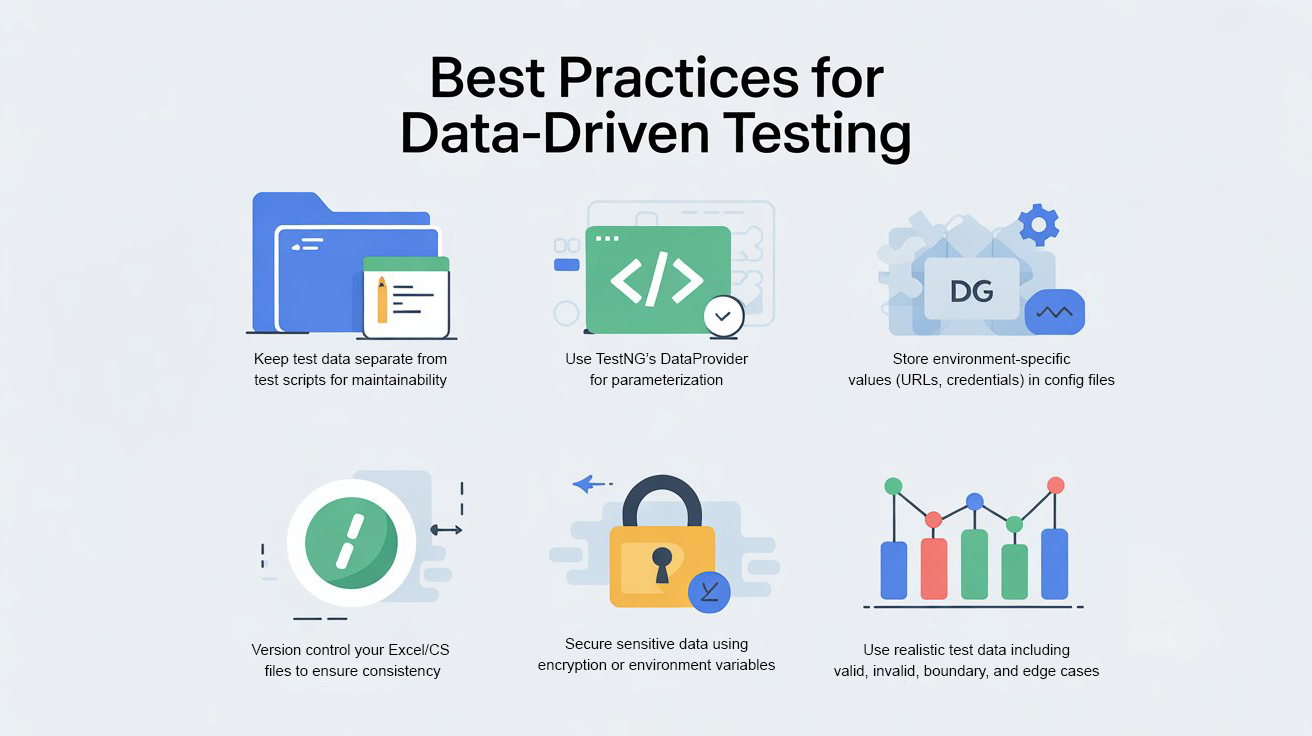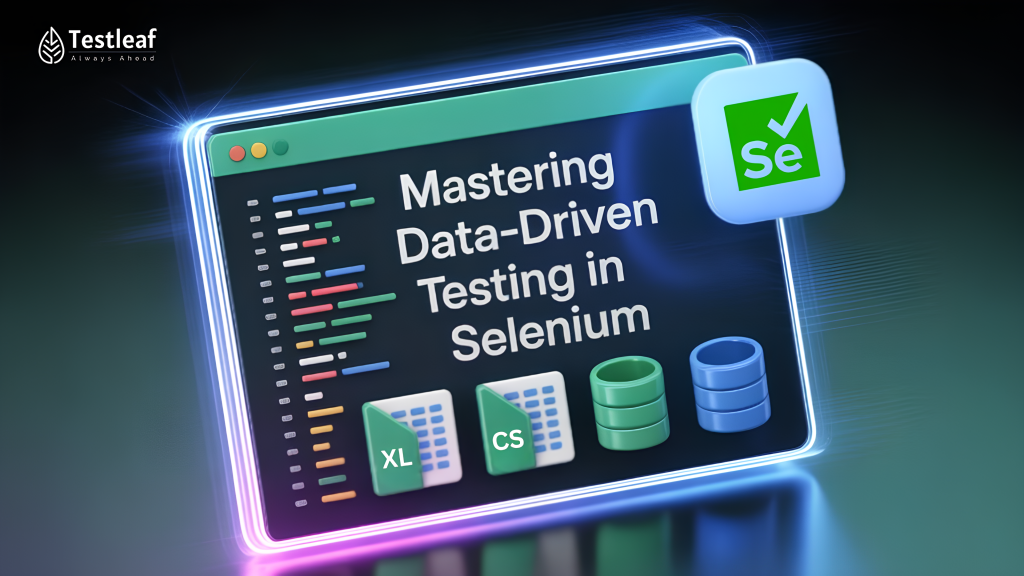When we talk about Selenium test automation at scale, one concept that consistently comes up is Data-Driven Testing (DDT). Imagine writing a login test for a web application. If you hardcode the username and password inside the script, you will only test one scenario. But in real-world testing, you’ll often need to validate multiple combinations of input values — valid credentials, invalid inputs, empty fields, special characters, and more. Instead of writing dozens of separate test scripts, DDT allows you to create one script that runs with multiple datasets. This not only saves time but also ensures broader coverage and reduces code duplication.
In Selenium, DDT can be implemented by separating the test logic from the test data. The test data is stored externally in sources like Excel spreadsheets, CSV files, or databases. During test execution, this data is fed into the scripts dynamically, making the framework highly scalable and maintainable.
1. What is Data-Driven Testing in Selenium?
Data-driven testing is a methodology where test input values are maintained outside the codebase and supplied to the automation framework during runtime. Instead of embedding test data inside scripts, it is stored in a structured external source, which makes the tests reusable and flexible.
Key benefits include:
– Run the same test logic with multiple sets of data.
– Update data files without touching test scripts.
– Achieve broader coverage with fewer test scripts.
– Ideal for regression testing where input values frequently change.
For example, in testing a CRM login page:
– Hardcoded test: username = DemoSalesManager, password = crmsfa
– Data-driven test: Read 50 username-password pairs from an Excel/CSV/DB file and reuse the same test logic for each pair.
Popular Articles: automation testing interview questions
2. Using Excel for Data-Driven Testing
Excel is one of the most common ways to store test data because it is simple, widely understood, and easily editable. Selenium does not directly interact with Excel, so libraries like Apache POI are used in Java to read and write Excel data.
Here’s an example structure for test data in Excel:
| Username | Password |
|—————–|———–|
| DemoSalesManager| crmsfa |
| TestLeafUser | test123 |
| InvalidUser | wrongpass |
A Selenium script can loop through each row and execute the same login test against all listed inputs.
Sample Java code with Apache POI and TestNG DataProvider:
“`java
import org.apache.poi.ss.usermodel.*;
import org.apache.poi.xssf.usermodel.XSSFWorkbook;
import org.openqa.selenium.By;
import org.openqa.selenium.WebDriver;
import org.openqa.selenium.chrome.ChromeDriver;
import org.testng.annotations.DataProvider;
import org.testng.annotations.Test;
import java.io.FileInputStream;
import java.io.IOException;public class ExcelDDTWithDataProvider {
@DataProvider(name = “excelData”)
public Object[][] getExcelData() throws IOException {
FileInputStream fis = new FileInputStream(“TestData.xlsx”);
Workbook workbook = new XSSFWorkbook(fis);
Sheet sheet = workbook.getSheet(“LoginData”);
int rows = sheet.getLastRowNum();
int cols = sheet.getRow(0).getLastCellNum();Object[][] data = new Object[rows][cols];
for (int i = 1; i <= rows; i++) {
for (int j = 0; j < cols; j++) {
data[i – 1][j] = sheet.getRow(i).getCell(j).toString();
}
}
workbook.close();
return data;
}@Test(dataProvider = “excelData”)
public void loginTest(String username, String password) {
WebDriver driver = new ChromeDriver();
driver.get(“https://example.com/login”);
driver.findElement(By.id(“username”)).sendKeys(username);
driver.findElement(By.id(“password”)).sendKeys(password);
driver.findElement(By.id(“loginBtn”)).click();
driver.quit();
}
}
“`
3. Using CSV Files for Data-Driven Testing
CSV files are lighter and faster compared to Excel. They are easy to maintain and ideal for simple datasets. In Java, the OpenCSV library is commonly used to handle CSV files.
Sample CSV file:
“`
Username,Password
DemoSalesManager,crmsfa
TestLeafUser,test123
InvalidUser,wrongpass
“`
Sample Java code with OpenCSV and DataProvider:
“`java
import com.opencsv.CSVReader;
import org.openqa.selenium.By;
import org.openqa.selenium.WebDriver;
import org.openqa.selenium.chrome.ChromeDriver;
import org.testng.annotations.DataProvider;
import org.testng.annotations.Test;
import java.io.FileReader;
import java.util.ArrayList;
import java.util.List;public class CsvDDTWithDataProvider {
@DataProvider(name = “csvData”)
public Object[][] getCsvData() throws Exception {
CSVReader reader = new CSVReader(new FileReader(“TestData.csv”));
List<Object[]> records = new ArrayList<>();
String[] record;
reader.readNext(); // skip headerwhile ((record = reader.readNext()) != null) {
records.add(new Object[]{record[0], record[1]});
}
reader.close();
return records.toArray(new Object[0][0]);
}@Test(dataProvider = “csvData”)
public void loginTest(String username, String password) {
WebDriver driver = new ChromeDriver();
driver.get(“https://example.com/login”);
driver.findElement(By.id(“username”)).sendKeys(username);
driver.findElement(By.id(“password”)).sendKeys(password);
driver.findElement(By.id(“loginBtn”)).click();
driver.quit();
}
}
“`
4. Using Databases for Data-Driven Testing
For enterprise-level testing, databases are often the best source of truth. They allow dynamic queries and provide centralized data management. Selenium integrates with databases using JDBC.
Sample table `logindata`:
| username | password |
|——————|———–|
| DemoSalesManager | crmsfa |
| TestLeafUser | test123 |
| InvalidUser | wrong |
Sample Java code with JDBC and DataProvider:
“`java
import org.openqa.selenium.By;
import org.openqa.selenium.WebDriver;
import org.openqa.selenium.chrome.ChromeDriver;
import org.testng.annotations.DataProvider;
import org.testng.annotations.Test;
import java.sql.*;
import java.util.ArrayList;
import java.util.List;public class DbDDTWithDataProvider {
@DataProvider(name = “dbData”)
public Object[][] getDbData() throws Exception {
Connection con = DriverManager.getConnection(
“jdbc:mysql://localhost:3306/testdb”, “root”, “password”);
Statement stmt = con.createStatement();
ResultSet rs = stmt.executeQuery(“SELECT username, password FROM logindata”);
List<Object[]> data = new ArrayList<>();while (rs.next()) {
data.add(new Object[]{rs.getString(“username”), rs.getString(“password”)});
}
rs.close(); stmt.close(); con.close();
return data.toArray(new Object[0][0]);
}@Test(dataProvider = “dbData”)
public void loginTest(String username, String password) {
WebDriver driver = new ChromeDriver();
driver.get(“https://example.com/login”);
driver.findElement(By.id(“username”)).sendKeys(username);
driver.findElement(By.id(“password”)).sendKeys(password);
driver.findElement(By.id(“loginBtn”)).click();
driver.quit();
}
}
“`
5. Best Practices for Data-Driven Testing
– Keep test data separate from test scripts for maintainability.
– Use TestNG’s DataProvider for parameterization.
– Store environment-specific values (URLs, credentials) in config files.
– Secure sensitive data using encryption or environment variables.
– Version control your Excel/CSV files to ensure consistency.
– Use realistic test data including valid, invalid, boundary, and edge cases.

Conclusion
Data-Driven Testing is a core practice for building scalable Selenium automation frameworks. By separating test logic from test data, you reduce duplication, improve maintainability, and achieve broader test coverage. Excel provides simplicity, CSV offers lightweight performance, and databases deliver enterprise-grade flexibility. Starting small with Excel or CSV is ideal for beginners, while mature projects can transition to database-driven tests for maximum scalability.
With Data-Driven Testing, QA engineers and automation testers can ensure their scripts are efficient, reusable, and robust enough to handle the ever-changing nature of real-world applications.
FAQs
What is Data-Driven Testing in Selenium?
Data-Driven Testing (DDT) is a methodology in which test data is separated from the script and provided from external sources like Excel, CSV, or databases. This allows automation scripts to run with multiple datasets, reducing redundancy and enhancing test coverage.
How do you implement Data-Driven Testing with Excel in Selenium?
You can implement DDT with Excel in Selenium by using libraries like Apache POI in Java. Test data is read from Excel files and used to drive Selenium scripts, allowing you to execute the same tests with different data sets.
What are the advantages of using CSV files for Data-Driven Testing?
CSV files are lightweight, easy to maintain, and faster for handling simple datasets compared to Excel. They are ideal for smaller-scale testing needs and can be easily integrated into Selenium using libraries like OpenCSV.
How do databases play a role in Data-Driven Testing with Selenium?
Databases provide dynamic and centralized management of test data, making them ideal for large-scale, enterprise-level testing. Selenium integrates with databases through JDBC, allowing for efficient query-based test data retrieval.
What are the best practices for implementing Data-Driven Testing in Selenium?
Best practices include:
-
Keeping test data separate from test scripts for easier maintenance.
-
Using TestNG’s DataProvider for parameterization.
-
Securing sensitive data through encryption.
-
Storing environment-specific values in config files.
-
Version controlling your test data files.
We Also Provide Training In:
- Advanced Selenium Training
- Playwright Training
- Gen AI Training
- AWS Training
- REST API Training
- Full Stack Training
- Appium Training
- DevOps Training
- JMeter Performance Training
Author’s Bio:

As a Senior SDET with 8+ years in testing and development, I build scalable automation platforms ensuring quality at speed. Passionate about mentoring and innovation, I equip teams with real-time solutions and high-impact frameworks, driving excellence through continuous learning. Let’s shape the future of quality engineering together.
Dilipkumar Rajendran
Senior SDET | Playwright & Selenium Expert









